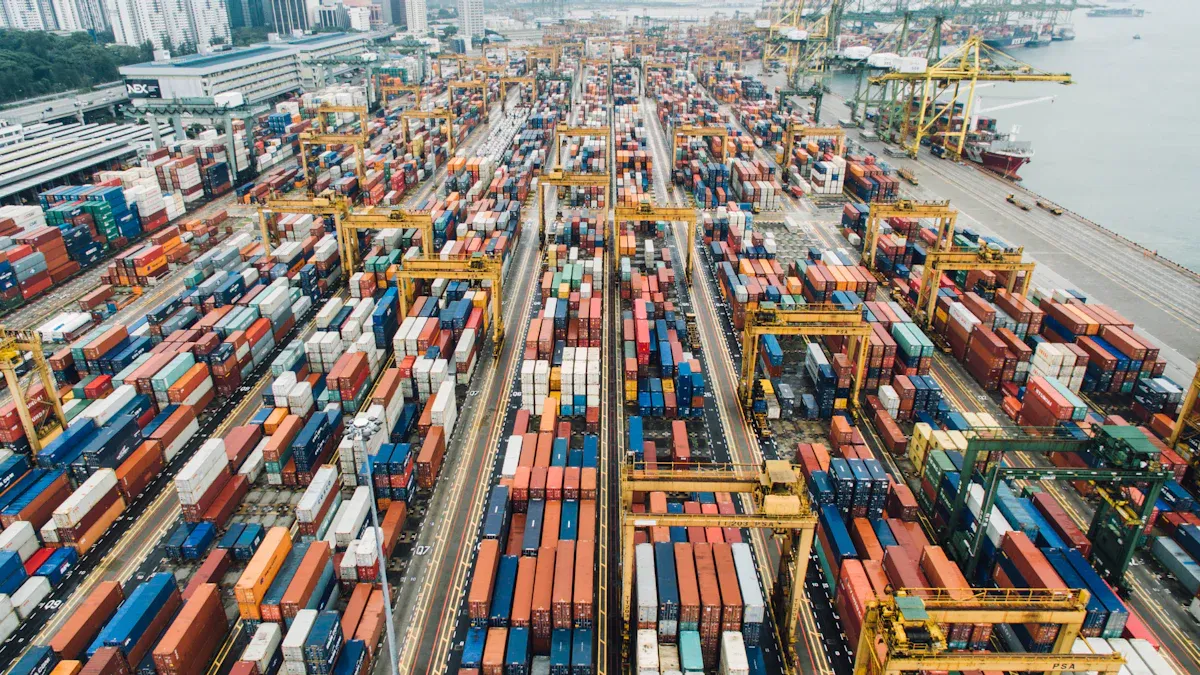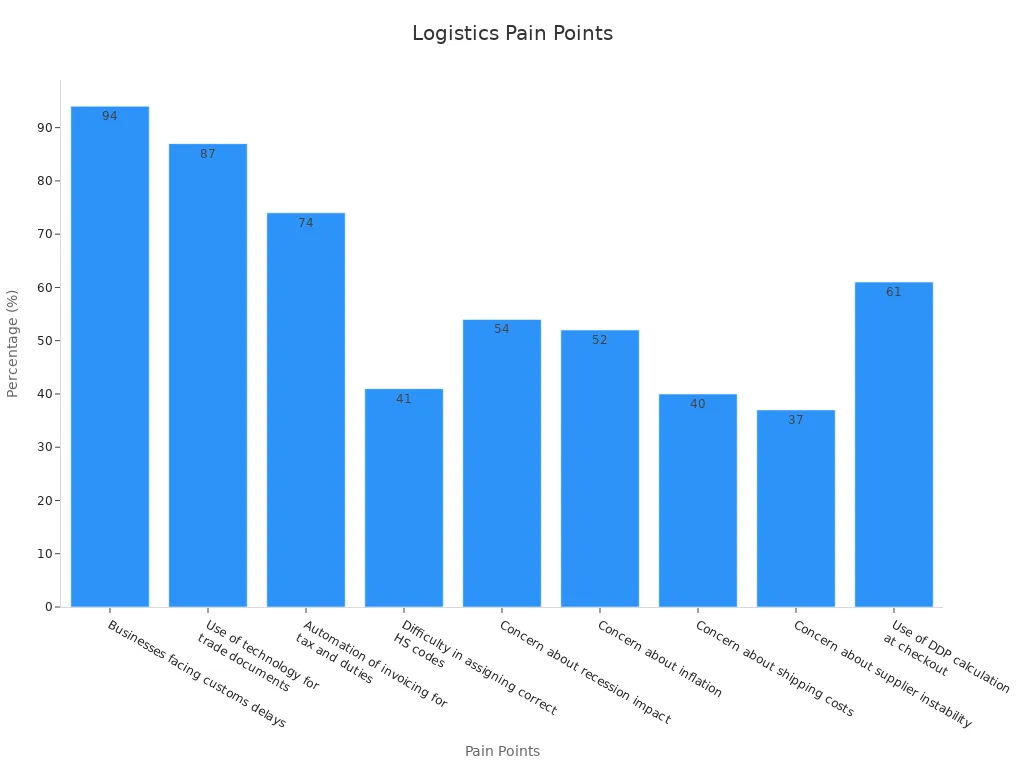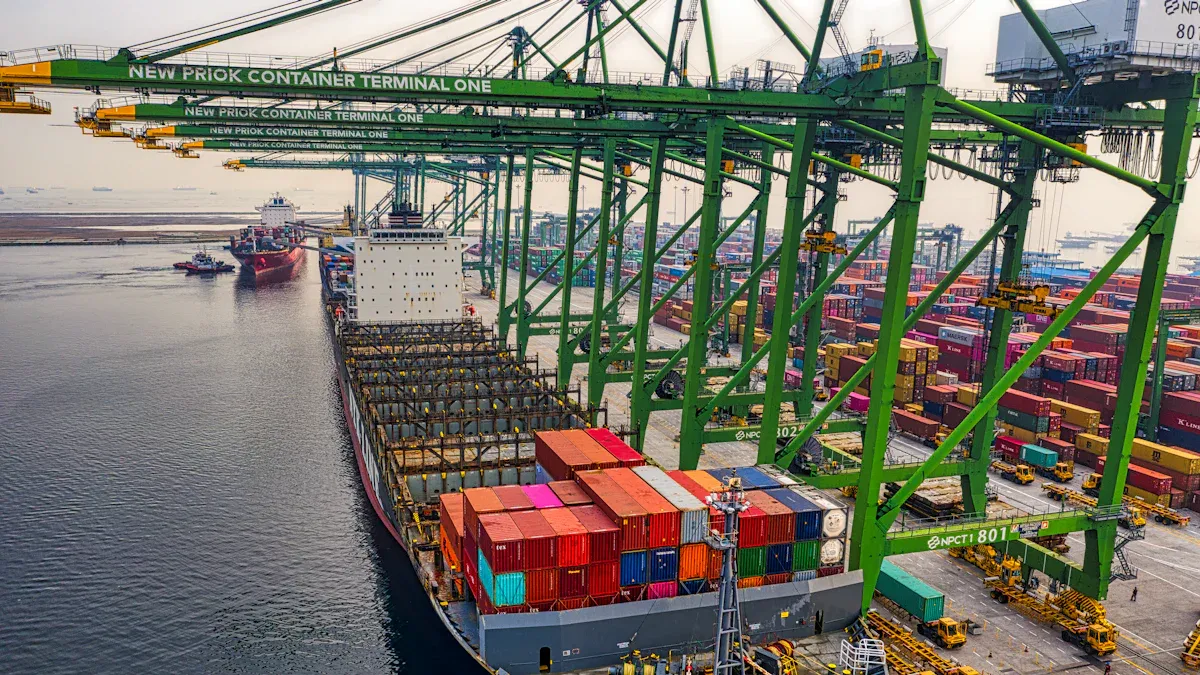Understanding and Addressing Cross-Border E-Commerce Logistics Problems

Cross-border e-commerce logistics are hard to manage. Many companies have problems with customs delays. They also pay high shipping costs. Some have trouble following the rules. The table below shows the most common problems in cross-border work.
Pain Point / Metric | Percentage (%) |
|---|---|
Businesses facing customs delays | |
Use of technology for trade documents | 87 |
Automation of invoicing for tax and duties | 74 |
Difficulty in assigning correct HS codes | 41 |
Concern about recession impact | 54 |
Concern about inflation | 52 |
Concern about shipping costs | 40 |
Concern about supplier instability | 37 |
Use of DDP calculation at checkout | 61 |

Solving cross-border e-commerce problems helps companies grow. It also makes customers happier. Companies that improve cross-border logistics deliver faster. They also do better in international ecommerce.
Key Takeaways
Cross-border e-commerce has big problems like customs delays, expensive shipping, and hard rules. These things make deliveries slow and lower profits.
Companies use technology, automation, and good partners to ship faster. This also helps them save money and make customers happier.
Careful planning, clear prices, and local payment choices help build trust. They stop surprises and make selling worldwide easier and better.
Cross-Border E-Commerce Logistics Challenges

Customs and Compliance
Customs and compliance problems make cross-border logistics hard. Companies must follow customs rules and meet strict standards. Sometimes, customs clearance takes hours or even days. This slows down shipments and sales. Rules often change, so it is hard for businesses to keep up. Delays at customs upset customers and slow trade. New technology like AI and big data help customs work better and follow the rules.
Shipping Costs and Delays
Shipping costs and delays are big worries in cross-border logistics. Freight rates on main trade routes have gone up by 3%. Problems like crowded ports and world events make shipping slower and more costly. These issues lower profits and make inventory harder to manage. Companies need a good plan to handle these risks.
Trade Lane | Freight Rate Increase | Key Impact |
|---|---|---|
Asia-US West Coast | +3% | Higher costs, longer transit |
Asia-N. Europe | +3% | Port congestion, higher prices |
Payment and Currency Barriers
Payment and currency problems make global e-commerce tricky. Many shoppers pay high fees when using foreign money. About half of buyers use dynamic currency conversion and pay more. New rules ask for clear payment info, but some buyers still struggle. Companies should give clear payment choices to build trust.
Inventory and Returns
Managing inventory and returns is tough after shipping. Return rates can be as high as 26%, mostly for electronics and clothes. Cross-border returns take weeks and cost more. This makes inventory less stable. Many stores use local warehouses to speed up returns and see their stock better.
Tracking and Visibility
Tracking and visibility are important during shipping problems. Real-time tracking helps deliveries be right by up to 20%. Better tracking makes customers happier and lowers complaints. Companies use IoT and AI to watch shipments and improve their logistics.
Communication and Culture
Communication and culture differences cause problems before shipping. Language and culture gaps affect trust and how people buy. Multilingual help and knowing about cultures help companies solve these problems.
Hidden and Unexpected Costs
Hidden and surprise costs often show up in cross-border logistics. These include customs duties, compliance fees, and extra shipping charges. Companies must plan for these costs to avoid surprises and keep profits safe.
Solutions for Cross-Border Logistics

Technology and Automation
Technology and automation help cross-border e-commerce work better. Companies use smart platforms to track orders and shipments. These tools also help with customs. JUSDA’s JusLink platform uses IoT, cloud computing, and big data. This system lets teams see shipments in real time. It helps them make fast choices. Automation cuts down on mistakes and manual work. Sharp used JUSDA’s platform to improve its logistics. Sharp saved 20% on logistics costs and 70% on labor costs. Orders arrived 30% faster. These results show technology can fix cross-border logistics problems.
When companies use automation and digital tools, shipping is faster. Inventory is easier to control. There are fewer mistakes. Companies also do better in global markets.
JUSDA’s China-Europe Express Rail
JUSDA’s China-Europe Express Rail is a special way to ship between China and Europe. This rail service gives a direct route. It cuts shipping time from 45 days to 26 days. The rail helps industries like cars, electronics, and medical supplies. It is faster than sea freight and cheaper than air freight. JUSDA makes sure customs go smoothly and deliveries are on time. The rail helps companies manage stock and meet customer needs.
A study shows that making decisions together in rail logistics helps profits. It also lowers transaction costs. JUSDA’s way matches these findings. It gives companies a strong plan for cross-border logistics in Europe.
3PL and Collaboration
Third-party logistics (3PL) providers are important in cross-border e-commerce. They share warehouses, trucks, and technology. This sharing lowers costs and uses assets better. 3PLs track inventory in real time and handle customs. Companies like Amazon FBA use 3PLs for fast deliveries and global orders.
JUSDA works with clients to build strong partnerships. These partnerships help companies reach more places and give better service. Clear deals and shared technology help businesses grow. The Sharp story shows working with JUSDA improved logistics and saved money.
Sharing resources saves money.
Real-time tracking helps see where things are.
Localized Payment and Support
Localized payment solutions help cross-border e-commerce. Companies team up with local payment providers. This makes payment systems fit each country’s rules. Local payment systems lower costs and keep payments safe. Customers trust brands that use payment methods they know.
Fast customer support is important too. Quick help with payments builds trust and loyalty. JUSDA gives flexible payment options and quick support. These steps make cross-border payments easier and safer.
Fast help fixes problems and keeps customers happy.
Safe systems stop fraud.
Transparent Pricing
Transparent pricing helps e-commerce companies avoid hidden fees. Clear prices stop confusion and build trust. Studies show clear pricing lowers costs and keeps prices steady. Customers pick cheaper options when prices are easy to see.
JUSDA shows all costs up front, like customs and shipping fees. This helps companies plan and protect profits. Clear pricing also helps people make smart choices and avoid surprise charges.
Clear pricing helps people make better choices and makes customers happier in global e-commerce.
Best Practices in Cross-Border E-Commerce
Proactive Planning
Good cross-border e-commerce starts with careful planning. Companies use special tools to guess delivery times. This helps them avoid surprises. AI tools help with customs and picking the best routes. This makes deliveries faster and with fewer mistakes. Working together on buying and planning saves money. It also makes the supply chain stronger. Companies that plan early can skip many common problems.
Careful planning helps companies deliver on time and keep customers happy.
Market Adaptation
Changing for new markets is important for global growth. Companies reach more people by using online sales and special products. Flexible prices and real-time data help them stay strong when the economy changes. Teams learn about different cultures and use CRM systems. This helps them talk to customers in a personal way. These steps help companies react fast to changes and what customers want.
Data and Visibility
Data and seeing what is happening help companies make better choices. They watch shipments live with GPS and IoT sensors. They check how well they do with things like delivery time and order accuracy. Analytics tools show where things slow down and help fix problems. When teams share data, they work better together and improve the whole supply chain.
Customer Experience
Customer experience is very important for cross-border e-commerce. Real-time delivery updates and special tracking pages keep customers in the loop. Easy returns and self-service make things simple for buyers. Clear shipping rules and many ways to pay stop people from leaving their carts. Using green packaging also makes customers happy and saves money.
Companies that care about customers make cross-border e-commerce smoother, faster, and more reliable.

JUSDA Solutions
To provide you with professional solutions and quotations.
Finding and fixing logistics problems helps businesses grow. It also makes customers happier. Companies using new technology and good teamwork get real results. The table below shows important numbers about better logistics.
Metric | Value | Impact |
|---|---|---|
Revenue Growth Rate | More sales and money for the business | |
On-Time Delivery Rate | 95% | Customers are more pleased |
Logistics Cost Reduction | Up to 15% | Saving money with better solutions |
When companies try new ideas and work together, their global operations get easier and better.
See Also
Revealing New Approaches To Supplier Partnerships In Global E-commerce
Addressing The Complexities Of Expanding Supply Chains Worldwide
How Supply Chain Transparency Drives Success In International E-commerce
Achieving Cross-Border Trade Growth Through JUSDA Solutions
Transforming Supply Chain Operations With Cloud Technology Innovations
